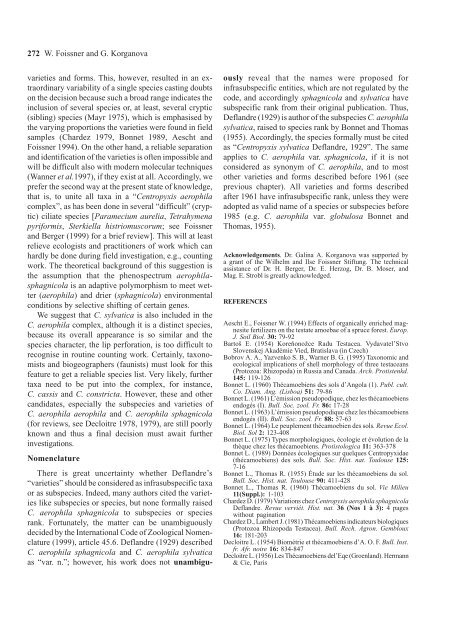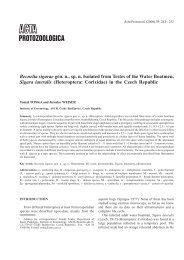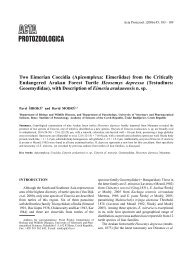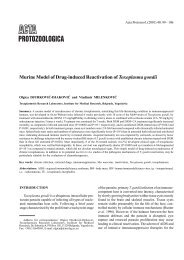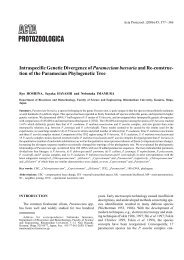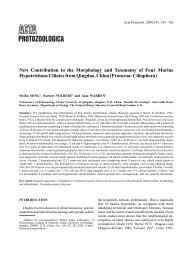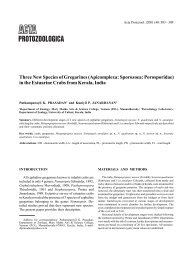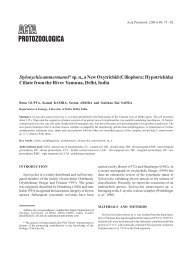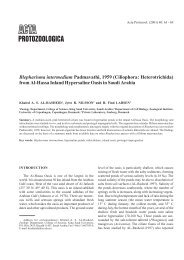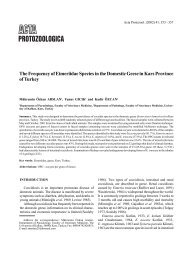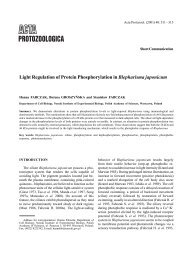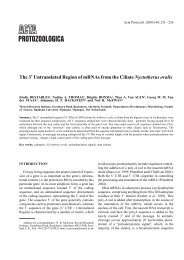The Centropyxis aerophila Complex (Protozoa: Testacea)
The Centropyxis aerophila Complex (Protozoa: Testacea)
The Centropyxis aerophila Complex (Protozoa: Testacea)
You also want an ePaper? Increase the reach of your titles
YUMPU automatically turns print PDFs into web optimized ePapers that Google loves.
272 W. Foissner and G. Korganova<br />
varieties and forms. This, however, resulted in an extraordinary<br />
variability of a single species casting doubts<br />
on the decision because such a broad range indicates the<br />
inclusion of several species or, at least, several cryptic<br />
(sibling) species (Mayr 1975), which is emphasised by<br />
the varying proportions the varieties were found in field<br />
samples (Chardez 1979, Bonnet 1989, Aescht and<br />
Foissner 1994). On the other hand, a reliable separation<br />
and identification of the varieties is often impossible and<br />
will be difficult also with modern molecular techniques<br />
(Wanner et al.1997), if they exist at all. Accordingly, we<br />
prefer the second way at the present state of knowledge,<br />
that is, to unite all taxa in a “<strong>Centropyxis</strong> <strong>aerophila</strong><br />
complex”, as has been done in several “difficult” (cryptic)<br />
ciliate species [Paramecium aurelia, Tetrahymena<br />
pyriformis, Sterkiella histriomuscorum; see Foissner<br />
and Berger (1999) for a brief review]. This will at least<br />
relieve ecologists and practitioners of work which can<br />
hardly be done during field investigation, e.g., counting<br />
work. <strong>The</strong> theoretical background of this suggestion is<br />
the assumption that the phenospectrum <strong>aerophila</strong>sphagnicola<br />
is an adaptive polymorphism to meet wetter<br />
(<strong>aerophila</strong>) and drier (sphagnicola) environmental<br />
conditions by selective shifting of certain genes.<br />
We suggest that C. sylvatica is also included in the<br />
C. <strong>aerophila</strong> complex, although it is a distinct species,<br />
because its overall appearance is so similar and the<br />
species character, the lip perforation, is too difficult to<br />
recognise in routine counting work. Certainly, taxonomists<br />
and biogeographers (faunists) must look for this<br />
feature to get a reliable species list. Very likely, further<br />
taxa need to be put into the complex, for instance,<br />
C. cassis and C. constricta. However, these and other<br />
candidates, especially the subspecies and varieties of<br />
C. <strong>aerophila</strong> <strong>aerophila</strong> and C. <strong>aerophila</strong> sphagnicola<br />
(for reviews, see Decloitre 1978, 1979), are still poorly<br />
known and thus a final decision must await further<br />
investigations.<br />
Nomenclature<br />
<strong>The</strong>re is great uncertainty whether Deflandre’s<br />
“varieties” should be considered as infrasubspecific taxa<br />
or as subspecies. Indeed, many authors cited the varieties<br />
like subspecies or species, but none formally raised<br />
C. <strong>aerophila</strong> sphagnicola to subspecies or species<br />
rank. Fortunately, the matter can be unambiguously<br />
decided by the International Code of Zoological Nomenclature<br />
(1999), article 45.6. Deflandre (1929) described<br />
C. <strong>aerophila</strong> sphagnicola and C. <strong>aerophila</strong> sylvatica<br />
as “var. n.”; however, his work does not unambiguously<br />
reveal that the names were proposed for<br />
infrasubspecific entities, which are not regulated by the<br />
code, and accordingly sphagnicola and sylvatica have<br />
subspecific rank from their original publication. Thus,<br />
Deflandre (1929) is author of the subspecies C. <strong>aerophila</strong><br />
sylvatica, raised to species rank by Bonnet and Thomas<br />
(1955). Accordingly, the species formally must be cited<br />
as “<strong>Centropyxis</strong> sylvatica Deflandre, 1929”. <strong>The</strong> same<br />
applies to C. <strong>aerophila</strong> var. sphagnicola, if it is not<br />
considered as synonym of C. <strong>aerophila</strong>, and to most<br />
other varieties and forms described before 1961 (see<br />
previous chapter). All varieties and forms described<br />
after 1961 have infrasubspecific rank, unless they were<br />
adopted as valid name of a species or subspecies before<br />
1985 (e.g. C. <strong>aerophila</strong> var. globulosa Bonnet and<br />
Thomas, 1955).<br />
Acknowledgements. Dr. Galina A. Korganova was supported by<br />
a grant of the Wilhelm and Ilse Foissner Stiftung. <strong>The</strong> technical<br />
assistance of Dr. H. Berger, Dr. E. Herzog, Dr. B. Moser, and<br />
Mag. E. Strobl is greatly acknowledged.<br />
REFERENCES<br />
Aescht E., Foissner W. (1994) Effects of organically enriched magnesite<br />
fertilizers on the testate amoebae of a spruce forest. Europ.<br />
J. Soil Biol. 30: 79-92<br />
Bartoš E. (1954) Koreòonožce Radu <strong>Testacea</strong>. Vydavatel’Stvo<br />
Slovenskej Akadémie Vied, Bratislava (in Czech)<br />
Bobrov A. A., Yazvenko S. B., Warner B. G. (1995) Taxonomic and<br />
ecological implications of shell morphology of three testaceans<br />
(<strong>Protozoa</strong>: Rhizopoda) in Russia and Canada. Arch. Protistenkd.<br />
145: 119-126<br />
Bonnet L. (1960) Thécamoebiens des sols d’Angola (1). Publ. cult.<br />
Co. Diam. Ang. (Lisboa) 51: 79-86<br />
Bonnet L. (1961) L’émission pseudopodique, chez les thécamoebiens<br />
endogés (I). Bull. Soc. zool. Fr. 86: 17-28<br />
Bonnet L. (1963) L’émission pseudopodique chez les thécamoebiens<br />
endogés (II). Bull. Soc. zool. Fr. 88: 57-63<br />
Bonnet L. (1964) Le peuplement thécamoebien des sols. Revue Ecol.<br />
Biol. Sol 2: 123-408<br />
Bonnet L. (1975) Types morphologiques, écologie et évolution de la<br />
thèque chez les thécamoebiens. Protistologica 11: 363-378<br />
Bonnet L. (1989) Données écologiques sur quelques Centropyxidae<br />
(thécamoebiens) des sols. Bull. Soc. Hist. nat. Toulouse 125:<br />
7-16<br />
Bonnet L., Thomas R. (1955) Étude sur les thécamoebiens du sol.<br />
Bull. Soc. Hist. nat. Toulouse 90: 411-428<br />
Bonnet L., Thomas R. (1960) Thécamoebiens du sol. Vie Milieu<br />
11(Suppl.): 1-103<br />
Chardez D. (1979) Variations chez <strong>Centropyxis</strong> <strong>aerophila</strong> sphagnicola<br />
Deflandre. Revue verviét. Hist. nat. 36 (Nos 1 à 3): 4 pages<br />
without pagination<br />
Chardez D., Lambert J. (1981) Thécamoebiens indicateurs biologiques<br />
(<strong>Protozoa</strong> Rhizopoda <strong>Testacea</strong>). Bull. Rech. Agron. Gembloux<br />
16: 181-203<br />
Decloitre L. (1954) Biométrie et thécamoebiens d’A. O. F. Bull. Inst.<br />
fr. Afr. noire 16: 834-847<br />
Decloitre L. (1956) Les Thécamoebiens del’Eqe (Groenland). Hermann<br />
& Cie, Paris


